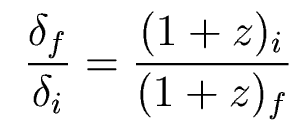The Growth of Primordial Fluctuations
What are our earliest hints of structure formation
in the Universe?
-
The cosmic microwave background
-- we see temperature fluctuations in the CMB of one part in 105.
Because radiation and baryons are coupled before recombination, these fluctuations
in the radiation field tell us what the fluctuations in the baryon density
are.
-
High redshift objects
-- the highest redshift object we can see are quasars and galaxies at redshifts
of ~ 5. A galaxy is a very strong "fluctuation" in density (ie the density
of a galaxy is much greater than the density of the universe as a whole).
Can we get there? If we let the very small
density fluctuations we see in the CMB evolve with time, will they form
the very large density fluctuations we see in high redshift galaxies and
quasars?
Let's look at how fluctuations in density evolve with
time. For simplicity, we will concentrate on a flat, matter-dominated universe
(so OmegaM=1). Look at the Friedman
equation:
 Now let's look at a small piece of this universe which has
a little more matter than the rest. It evolves slightly differently, because
of the excess matter:
Now let's look at a small piece of this universe which has
a little more matter than the rest. It evolves slightly differently, because
of the excess matter:
 Subtract one equation from the other, and we get
Subtract one equation from the other, and we get
 or
or

Let's define a quantity called delta,
which is the fractional overdensity
of the region:
 and look how delta depends on the evolving quantities, R
and rho:
and look how delta depends on the evolving quantities, R
and rho:
 So as the universe gets bigger, the overdensity grows along
with it. But since size and redshift are related R = (1+z)-1,
we can rewrite this as
So as the universe gets bigger, the overdensity grows along
with it. But since size and redshift are related R = (1+z)-1,
we can rewrite this as

or we can relate the density fluctuations at two times
as

The CMB is a picture of the universe at a redshift of
z ~ 1000. So if we let the CMB fluctuations (delta ~ 10-5) grow
from z=1000 to z=5, they will have evolved into density fluctuations on
the order of

Egad! That's too low by orders
of magnitude!! By themselves, these density fluctuations
don't have enough mass to grow into galaxies.
But there's more than just baryons -- there's dark
matter. How does that affect things?









